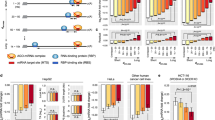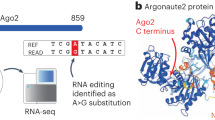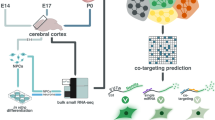Abstract
MicroRNAs (miRNAs) regulate mRNA targets through perfect pairing with their seed region (positions 2–7). Recently, a precise genome-wide map of miRNA interaction sites in mouse brain was generated by high-throughput sequencing and analysis of clusters of ~50-nucleotide mRNA tags cross-linked to Argonaute (Ago HITS-CLIP). By analyzing Ago HITS-CLIP 'orphan clusters'—Ago binding regions from HITS-CLIP that cannot be explained by canonical seed matches—we have now identified an alternative binding mode used by miRNAs. Specifically, G-bulge sites (positions 5–6) are often bound and regulated by miR-124 in brain. More generally, bulged sites comprise ≥15% of all Ago-miRNA interactions in mouse brain and are evolutionarily conserved. We call position 6 the 'pivot' nucleotide and suggest a model in which a transitional 'nucleation bulge' leads to functional bulge mRNA-miRNA interactions, expanding the number of potential miRNA regulatory sites.
This is a preview of subscription content, access via your institution
Access options
Subscribe to this journal
Receive 12 print issues and online access
$209.00 per year
only $17.42 per issue
Buy this article
- Purchase on SpringerLink
- Instant access to full article PDF
Prices may be subject to local taxes which are calculated during checkout





Similar content being viewed by others
References
Sharp, P.A. The centrality of RNA. Cell 136, 577–580 (2009).
Licatalosi, D.D. & Darnell, R.B. RNA processing and its regulation: global insights into biological networks. Nat. Rev. Genet. 11, 75–87 (2010).
Ambros, V. The functions of animal microRNAs. Nature 431, 350–355 (2004).
He, L. & Hannon, G.J. MicroRNAs: small RNAs with a big role in gene regulation. Nat. Rev. Genet. 5, 522–531 (2004).
Bartel, D.P. MicroRNAs: target recognition and regulatory functions. Cell 136, 215–233 (2009).
Lewis, B.P., Burge, C.B. & Bartel, D.P. Conserved seed pairing, often flanked by adenosines, indicates that thousands of human genes are microRNA targets. Cell 120, 15–20 (2005).
Long, D. et al. Potent effect of target structure on microRNA function. Nat. Struct. Mol. Biol. 14, 287–294 (2007).
Grimson, A. et al. MicroRNA targeting specificity in mammals: determinants beyond seed pairing. Mol. Cell 27, 91–105 (2007).
Lim, L.P. et al. Microarray analysis shows that some microRNAs downregulate large numbers of target mRNAs. Nature 433, 769–773 (2005).
Baek, D. et al. The impact of microRNAs on protein output. Nature 455, 64–71 (2008).
Selbach, M. et al. Widespread changes in protein synthesis induced by microRNAs. Nature 455, 58–63 (2008).
Mourelatos, Z. Small RNAs: the seeds of silence. Nature 455, 44–45 (2008).
Easow, G., Teleman, A.A. & Cohen, S.M. Isolation of microRNA targets by miRNP immunopurification. RNA 13, 1198–1204 (2007).
Ha, I., Wightman, B. & Ruvkun, G. A bulged lin-4/lin-14 RNA duplex is sufficient for Caenorhabditis elegans lin-14 temporal gradient formation. Genes Dev. 10, 3041–3050 (1996).
Vella, M.C., Choi, E.Y., Lin, S.Y., Reinert, K. & Slack, F.J. The C. elegans microRNA let-7 binds to imperfect let-7 complementary sites from the lin-41 3′UTR. Genes Dev. 18, 132–137 (2004).
Tay, Y., Zhang, J., Thomson, A.M., Lim, B. & Rigoutsos, I. MicroRNAs to Nanog, Oct4 and Sox2 coding regions modulate embryonic stem cell differentiation. Nature 455, 1124–1128 (2008).
Didiano, D. & Hobert, O. Perfect seed pairing is not a generally reliable predictor for miRNA-target interactions. Nat. Struct. Mol. Biol. 13, 849–851 (2006).
Hammell, M. et al. mirWIP: microRNA target prediction based on microRNA-containing ribonucleoprotein-enriched transcripts. Nat. Methods 5, 813–819 (2008).
Karginov, F.V. et al. A biochemical approach to identifying microRNA targets. Proc. Natl. Acad. Sci. USA 104, 19291–19296 (2007).
Ule, J. et al. CLIP identifies Nova-regulated RNA networks in the brain. Science 302, 1212–1215 (2003).
Licatalosi, D.D. et al. HITS-CLIP yields genome-wide insights into brain alternative RNA processing. Nature 456, 464–469 (2008).
Darnell, R.B. HITS-CLIP: panoramic views of protein-RNA regulation in living cells. Wiley Interdiscip. Rev. RNA 1, 266–286 (2010).
Chi, S.W., Zang, J.B., Mele, A. & Darnell, R.B. Argonaute HITS-CLIP decodes microRNA-mRNA interaction maps. Nature 460, 479–486 (2009).
Zisoulis, D.G. et al. Comprehensive discovery of endogenous Argonaute binding sites in Caenorhabditis elegans . Nat. Struct. Mol. Biol. 17, 173–179 (2010).
Hafner, M. et al. Transcriptome-wide identification of RNA-binding protein and microRNA target sites by PAR-CLIP. Cell 141, 129–141 (2010).
Leung, A.K. et al. Genome-wide identification of Ago2 binding sites from mouse embryonic stem cells with and without mature microRNAs. Nat. Struct. Mol. Biol. 18, 237–244 (2011).
Bailey, T.L. & Elkan, C. Fitting a mixture model by expectation maximization to discover motifs in biopolymers. Proc. Int. Conf. Intell. Syst. Mol. Biol. 2, 28–36 (1994).
Khan, A.A. et al. Transfection of small RNAs globally perturbs gene regulation by endogenous microRNAs. Nat. Biotechnol. 27, 549–555 (2009).
Giraldez, A.J. et al. Zebrafish MiR-430 promotes deadenylation and clearance of maternal mRNAs. Science 312, 75–79 (2006).
Linsley, P.S. et al. Transcripts targeted by the microRNA-16 family cooperatively regulate cell cycle progression. Mol. Cell. Biol. 27, 2240–2252 (2007).
Kawahara, Y. et al. Redirection of silencing targets by adenosine-to-inosine editing of miRNAs. Science 315, 1137–1140 (2007).
Zhao, Y. et al. Dysregulation of cardiogenesis, cardiac conduction, and cell cycle in mice lacking miRNA-1–2. Cell 129, 303–317 (2007).
Gehrke, S., Imai, Y., Sokol, N. & Lu, B. Pathogenic LRRK2 negatively regulates microRNA-mediated translational repression. Nature 466, 637–641 (2010).
Song, J.J., Smith, S.K., Hannon, G.J. & Joshua-Tor, L. Crystal structure of Argonaute and its implications for RISC slicer activity. Science 305, 1434–1437 (2004).
Wang, Y. et al. Structure of an argonaute silencing complex with a seed-containing guide DNA and target RNA duplex. Nature 456, 921–926 (2008).
Wang, Y., Sheng, G., Juranek, S., Tuschl, T. & Patel, D.J. Structure of the guide-strand-containing argonaute silencing complex. Nature 456, 209–213 (2008).
Wang, Y. et al. Nucleation, propagation and cleavage of target RNAs in Ago silencing complexes. Nature 461, 754–761 (2009).
Tinoco, I. Jr. & Bustamante, C. How RNA folds. J. Mol. Biol. 293, 271–281 (1999).
Parker, J.S., Parizotto, E.A., Wang, M., Roe, S.M. & Barford, D. Enhancement of the seed-target recognition step in RNA silencing by a PIWI/MID domain protein. Mol. Cell 33, 204–214 (2009).
Lal, A. et al. miR-24 Inhibits cell proliferation by targeting E2F2, MYC, and other cell-cycle genes via binding to 'seedless' 3′UTR microRNA recognition elements. Mol. Cell 35, 610–625 (2009).
Shin, C. et al. Expanding the microRNA targeting code: functional sites with centered pairing. Mol. Cell 38, 789–802 (2010).
Rehmsmeier, M., Steffen, P., Hochsmann, M. & Giegerich, R. Fast and effective prediction of microRNA/target duplexes. RNA 10, 1507–1517 (2004).
Nelson, P.T. et al. A novel monoclonal antibody against human Argonaute proteins reveals unexpected characteristics of miRNAs in human blood cells. RNA 13, 1787–1792 (2007).
Brown, V. et al. Microarray identification of FMRP-associated brain mRNAs and altered mRNA translational profiles in fragile X syndrome. Cell 107, 477–487 (2001).
Acknowledgements
We thank the members of the Darnell and Hannon laboratories for helpful discussions. This work was supported in part by grants from the US National Institutes of Health (R.B.D. and G.J.H.) and a grant from the Korean Health Technology R&D Project, Ministry of Health & Welfare (A111989, to S.W.C.). R.B.D. and G.J.H. are investigators of the Howard Hughes Medical Institute.
Author information
Authors and Affiliations
Contributions
S.W.C. carried out the experiments and computational analyses. S.W.C. and R.B.D. analyzed the data. S.W.C., G.J.H. and R.B.D. designed the research and wrote the paper.
Corresponding authors
Ethics declarations
Competing interests
The authors declare no competing financial interests.
Supplementary information
Supplementary Text and Figures
Supplementary Figures 1–7, Supplementary Table 1 and Supplementary Methods (PDF 2261 kb)
Rights and permissions
About this article
Cite this article
Chi, S., Hannon, G. & Darnell, R. An alternative mode of microRNA target recognition. Nat Struct Mol Biol 19, 321–327 (2012). https://doi.org/10.1038/nsmb.2230
Received:
Accepted:
Published:
Issue Date:
DOI: https://doi.org/10.1038/nsmb.2230



